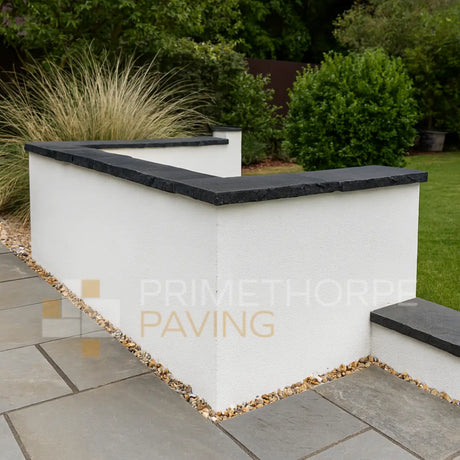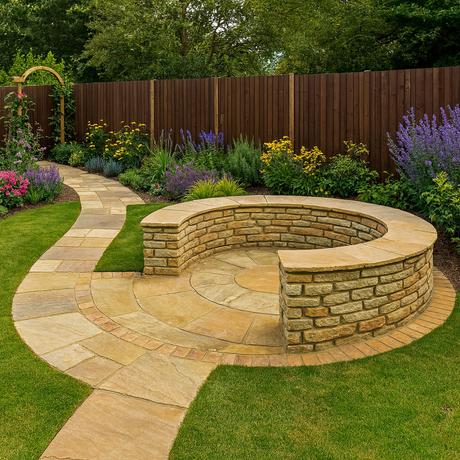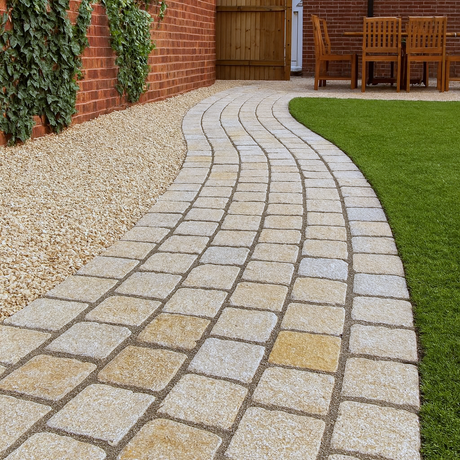Here at Primethorpe Paving, we are often asked if paving slabs can be used for a driveway. The simple answer is yes. Driveway flags and paving slabs work really well to create an attractive driveway. However, there are some considerations.
Driveway Foundations Are The Most Important thing
It's important to note that it is the foundations of your driveway that is going to have the most impact on the effectiveness of your slabs. As with a regular patio, a strong foundation is what gives the project it's longevity - and with the extra stress and strain the slabs will be under with vehicle traffic, the foundation needs to be perfect at even thicker than it would be for a regular patio.
With driveway slabs, the thicker the better. This means the driveway slabs will be stronger, sturdier and be able to last the test of time on your driveway for years to come.
As well as choosing the right driveway paving slabs, you need to get the sub-base right too. If your sub-base is not well laid, then your driveway will be much less durable and won’t be able to last as long as you hope. This is even the case if you choose the right thickness of driveway flags.
Take the time to ensure you lay the right sub-base with thick and solid driveway flags. This will provide a strong, durable and aesthetically pleasing driveway for your home for now and in the future.
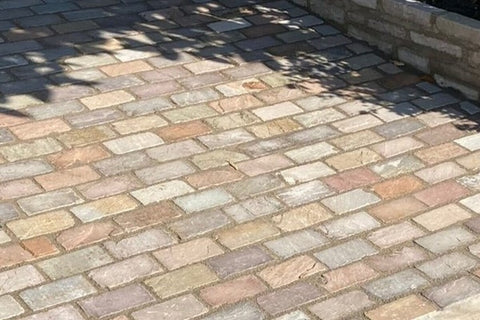
What Paving Slabs Can Be Used For Driveways?
There are two very distinctive driveway options. These are those that are manufactured from concrete and those that are manufactured from natural stone. Both natural stone and concrete have very different characteristics. When it comes to choosing the right driveway paving for your home, think carefully about your tastes.
Concrete Driveway Flags
Cheap, economy or budget wet-cast concrete slabs are rarely suitable as driveway slabs. This is because they tend to have low cement count and are not as strong as driveway paving slabs need to be to support the weight of vehicles. Cheaper pressed concrete slabs are rarely good for driveway slabs too as they are not designed to hold the weight or withstand the movement of vehicles.
If you are looking to use concrete flags, we recommend the better quality wet-cast or pressed concrete flags that are more costly as these will not let you down as the years go by. Alternatively, block paving is a good option.
Natural Stone Driveway Flags
Just as there is variation in the suitability of concrete flags for your driveway, it’s the same for natural stone flags for your driveway. The thin natural stone paving slabs will not be suitable for your driveway as they are not strong or robust enough. We recommend the heavier and commercially orientated flagstones that are over 20mm in thickness, as these are almost always suitable as paving for driveways.
However, some natural stone materials are better suited to coping with the weight and movement of vehicles. For example, sandstone is a popular material for natural stone driveway slabs.
What Colour Driveway Flags Should I Use?
Grey driveway slabs are a great choice for domestic driveways. This is because they will not show tyre markings as clearly as pale or light-coloured driveway slabs might. Naturally riven, cast of sawn grey driveway pavers will also be less easily marked than coarse textures of grey driveway slabs that have been shot-blated or bush-hammered too.
Your Driveway Edging Slabs & Cobbles
There is more to achieving your dream driveway than choosing the right driveway flags. You need to think about edging stones and kerbs too. These are essential to the look and performance of any driveway project.
We have an extensive choice of options to complement or contrast your driveway paving stones, just check out our range online. You can match the grey driveway slabs with grey edging, or your could contrast the grey pavers on your driveway with white or blacks kerbs to create something truly eye-catching and elegant.
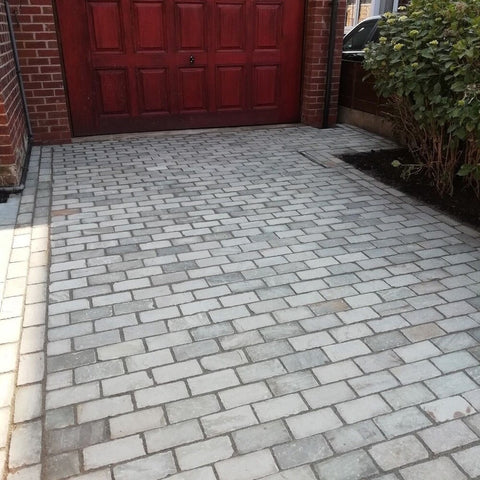
Is Indian Stone Suitable For Driveway Paving Slabs?
Indian stone is a hugely popular paving option across the UK for homeowners. Unsurprisingly, we are often asked if Indian stone is a suitable driveway paving option. The simple answer is yes, but it is dependent on the thickness of the driveway flags and the sub-base.
You’ll have seen that driveway slabs need to be 20mm thick, but this refers to the slab only - you also need to consider the thickness of the foundations and quality of sub-base, not just the driveway paving flag. The sub-base refers to the mortar bed the flagstones sit on and this should be at least 50mm thick and laid fully underneath the slabs with absolutely no gaps. Additionally, it's advisable that the foundations - another layer underneath this - are at least another 100mm thick including whacker plating them down to compact them.
As long as you have a strong sub-base, you can use Indian stone as your driveway paving flagstones.
Paving Your Driveway Boosts The Value Of Your Home
Research shows that a well laid paved driveway can boost the value of your property by between 5% and 10%! This can easily translate to thousands of pounds being added to the value of your home. However, you need to make sure that you choose the right driveway slabs for your home. If you do the job right, with the right tools and products, you’ll see a huge boost to the value of your property.
It's a huge job. What can sometimes pass as an adequate option for a patio, often will not be suitable for a driveway. The extra stress that will occur thanks to the vehicle traffic will mean that a basic foundation which you may ordinarily use for a garden, will fail much more quickly than it otherwise would. On top of what we have mentioned above, we would also recommend getting a professional to take on this project. A driveway is such an important part of a home, so you want it done to perfection.





